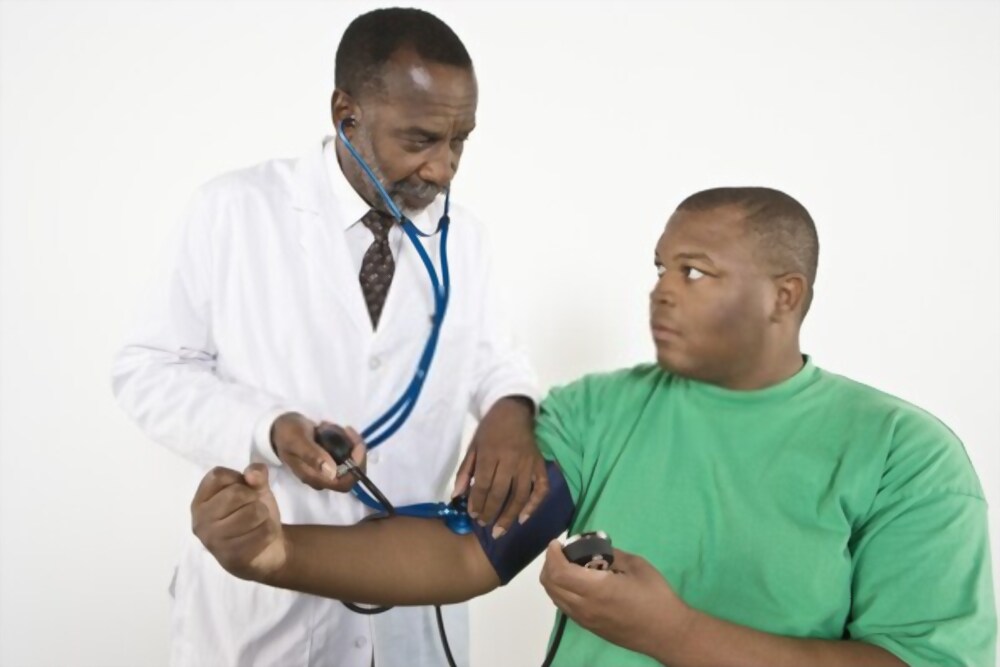
Written by Dr. Abimbola Owolabi, Consultant Family Physician
A stroke occurs when the blood supply to part of the brain is interrupted or reduced, preventing brain tissue from getting oxygen and nutrients. Brain cells begin to die in minutes. A stroke is a medical emergency, and prompt treatment is crucial. Early action can reduce brain damage and other complications.
Causes
There are two main causes of stroke: a blocked artery (Ischemic stroke) or leaking or bursting of a blood vessel (Hemorrhagic stroke). Some people may have only a temporary disruption of blood flow to the brain, known as a Transient ischemic attack (TIA), that doesn’t cause lasting symptoms.
Ischemic stroke
This is the most common type of stroke. It happens when the brain’s blood vessels become narrowed or blocked, causing severely reduced blood flow (ischemia). Blocked or narrowed blood vessels are caused by fatty deposits that build up in blood vessels or by blood clots or other debris that travel through the bloodstream and lodge in the blood vessels of the brain.
Hemorrhagic stroke
Hemorrhagic stroke occurs when a blood vessel in the brain leaks or ruptures. Brain hemorrhages can result from many conditions that affect blood vessels. Factors related to hemorrhagic stroke include:
- Uncontrolled high blood pressure
- Overtreatment with blood thinners (anticoagulants)
- Bulges at weak spots in your blood vessel walls (Aneurysms) Trauma (such as a car accident)
- Protein deposits in blood vessel walls that lead to weakness in the vessel wall (Cerebral amyloid angiopathy)
- Ischemic stroke leading to hemorrhage
- A less common cause of bleeding in the brain is the rupture of an abnormal tangle of thin-walled blood vessels (arteriovenous malformation).
Transient ischemic attack (TIA)
A transient ischemic attack (TIA) — sometimes known as a ministroke — is a temporary period of symptoms similar to those of a stroke. A TIA doesn’t cause permanent damage. They’re caused by a temporary decrease in blood supply to part of the brain, which may last as little as five minutes.
Like an ischemic stroke, a TIA occurs when a clot or debris reduces or blocks blood flow to part of the nervous system.
Risk factors
Many factors can increase the risk of stroke. Potentially treatable stroke risk factors include:
Lifestyle risk factors
- Being overweight or obese
- Physical inactivity
- Heavy or binge drinking
- Use of illegal drugs such as cocaine and methamphetamine
Medical risk factors
- High blood pressure
- Cigarette smoking or secondhand smoke exposure
- High cholesterol
- Diabetes
- Obstructive sleep apnea
- Cardiovascular disease, including heart failure, heart defects, heart infection or abnormal heart rhythm, such as atrial fibrillation
Personal or family history of stroke, heart attack or transient ischemic attack
Other factors associated with a higher risk of stroke include:
- Age — People age 55 or older have a higher risk of stroke than do younger people.
- Race — African Americans have a higher risk of stroke than do people of other races.
- Sex — Men have a higher risk of stroke than women. Women are usually older when they have strokes, and they’re more likely to die of strokes than are men.
- Hormones — Use of birth control pills or hormone therapies that include estrogen increases risk.
Signs and symptoms of stroke include:
- Trouble speaking and understanding what others are saying.
- Paralysis or numbness of the face, arm or leg. You may develop sudden numbness, weakness or paralysis in your face, arm or leg. This often affects just one side of your body.
- Problems seeing in one or both eyes. You may suddenly have blurred or blackened vision in one or both eyes, or you may see double.
- Headache. A sudden, severe headache, which may be accompanied by vomiting, dizziness or altered consciousness, may indicate a stroke.
- Trouble walking
Complications
A stroke can sometimes cause temporary or permanent disabilities, depending on how long the brain lacks blood flow and which part was affected. Complications may include:
- Paralysis or loss of muscle movement.
- Difficulty talking or swallowing, language, including speaking or understanding speech, reading, or writing.
- Memory loss or thinking difficulty
- Emotional problems. People who have had strokes may have more difficulty controlling their emotions, or they may develop depression.
- Pain,numbness or other unusual sensations may occur in the parts of the body affected by stroke.
- Changes in behavior and self-care ability. People who have had strokes may become more withdrawn. They may need help with grooming and daily chores.
Prevention
Knowing your stroke risk factors, following your doctor’s recommendations and adopting a healthy lifestyle are the best steps you can take to prevent a stroke. If you’ve had a stroke or a transient ischemic attack (TIA), these measures might help prevent another stroke. The follow-up care you receive in the hospital and afterward also may play a role.
Many stroke prevention strategies are the same as strategies to prevent heart disease. In general, healthy lifestyle recommendations include:
- Controlling high blood pressure (hypertension).This is one of the most important things you can do to reduce your stroke risk. If you’ve had a stroke, lowering your blood pressure can help prevent a subsequent TIA or stroke. Healthy lifestyle changes and medications are often used to treat high blood pressure.
- Lowering the amount of cholesterol and saturated fat in your diet. Eating less cholesterol and fat, especially saturated fat and trans fats, may reduce the buildup in your arteries. If you can’t control your cholesterol through dietary changes alone, your doctor may prescribe a cholesterol-lowering medication.
- Quitting tobacco use. Smoking raises the risk of stroke for smokers and nonsmokers exposed to secondhand smoke. Quitting tobacco use reduces your risk of stroke.
- Managing diabetes. Diet, exercise and losing weight can help you keep your blood sugar in a healthy range. If lifestyle factors don’t seem to be enough to control your diabetes, your doctor may prescribe diabetes medication.
- Maintaining a healthy weight. Being overweight contributes to other stroke risk factors, such as high blood pressure, cardiovascular disease and diabetes.
- Eating a diet rich in fruits and vegetables. A diet containing five or more daily servings of fruits or vegetables may reduce your risk of stroke. The Mediterranean diet, which emphasizes olive oil, fruit, nuts, vegetables and whole grains, may be helpful.
- Exercising regularly. Aerobic exercise reduces your risk of stroke in many ways. Exercise can lower your blood pressure, increase your levels of good cholesterol, and improve the overall health of your blood vessels and heart. It also helps you lose weight, control diabetes and reduce stress. Gradually work up to at least 30 minutes of moderate physical activity — such as walking, jogging, swimming or bicycling — on most, if not all, days of the week.
- Drinking alcohol in moderation, if at all. Heavy alcohol consumption increases your risk of high blood pressure, ischemic strokes and hemorrhagic strokes. Alcohol may also interact with other drugs you’re taking.
Management of acute stroke
The goal for the acute management of patients with stroke is to stabilize the patient and to complete initial evaluation and assessment, including imaging and laboratory studies, within 60 minutes of arrival.
Critical decisions focus on the need for intubation, blood pressure control, and determination of risk/benefit for thrombolytic intervention.
- Blood glucose-Treat hypoglycemia with D50.
Treat hyperglycemia with insulin if serum glucose >200 mg/dL
- Blood pressure- Optimal blood pressure targets remain to be determined. Many patients are hypertensive,the need for caution in lowering blood pressures acutely.Studies have demonstrated that blood pressure typically drops in the first 24 hours after acute stroke, whether or not antihypertensives are administered. Furthermore, studies have revealed poorer outcomes in patients with lower blood pressures, with these outcomes correlating with the degree of pressure decline.
The consensus recommendation is to lower blood pressure only if systolic pressure is in excess of 220 mm Hg or if diastolic pressure is greater than 120 mm Hg.However, a systolic blood pressure greater than 185 mm Hg or a diastolic pressure greater than 110 mm Hg is a contraindication to the use of thrombolytics. Therefore, the management of elevated blood pressure in acute ischemic stroke may vary, depending on whether the patient is a candidate for thrombolytic therapy.For patients with a systolic blood pressure above 220 mm Hg or a diastolic blood pressure greater than 120 mm Hg, labetalol (10-20 mg IV for 1-2 min) should be the initial drug of choice, unless a contraindication to its use exists. Dosing may be repeated or doubled every 10 minutes to a maximum dose of 300 mg.
Monitoring of blood pressure is crucial; for the first 2 hours, blood pressure should be checked every 15 minutes, then every 30 minutes for 6 hours, and finally, every hour for 16 hours. The goal of therapy should be to reduce blood pressure by 15-25% in the first day, with continued blood pressure control during hospitalization.The use of sublingual nifedipine to lower blood pressure in the ED is discouraged, since extreme hypotension may result.
- Cardiac monitor-Continuous monitoring for ischemic changes or atrial fibrillation
- Intravenous fluids-Avoid D5W and excessive fluid administration
IV isotonic sodium chloride solution at 50 mL/h unless otherwise indicated
- NPO initially; aspiration risk is great, avoid oral intake until swallowing
- Supplemental oxygen use should be guided by pulse oximetry. Patients should receive supplemental oxygen if their pulse oximetry reading or arterial blood gas measurement reveals that they are hypoxic (SaO< 94%). The most common causes of hypoxia in the patient with acute stroke are partial airway obstruction, hypoventilation, atelectasis, or aspiration of stomach or oropharyngeal contents.
- Current treatments for acute ischemic stroke include IV thrombolytic therapy with tissue-type plasminogen activator (t-PA) and endovascular therapies using stent retriever devices. Guidelines for the early management of patients with acute ischemic stroke recommends that patients eligible for intravenous t-PA should receive intravenous t-PA
Newer stroke trials have explored the benefit of using neuroimaging to select patients who are most likely to benefit from thrombolytic therapy and the potential benefits of extending the window for thrombolytic therapy beyond the guideline of 3 hours with t-PA and newer agents. CT angiography may demonstrate the location of vascular occlusion. CT perfusion studies are capable of producing perfusion images and together with CT angiography are becoming more available and utilized in the acute evaluation of stroke patient.




